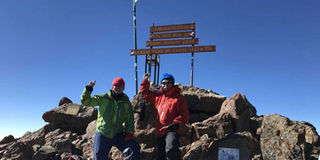Envoy: How I conquered Mt Kenya

Japanese ambassador to Kenya Toshitsugu Uesawa (right) who climbed Mt Kenya recently. PHOTO | CORRESPONDENT | NATION MEDIA GROUP
What you need to know:
- I travelled in a party of nine, which included a friend, a cook, a guide and some porters.
- The mountain ranges illuminated by the rising sun, and the sea of clouds that lay beneath us, provided for a breathtakingly beautiful scene.
It has been one-and-a-half years since I arrived in Nairobi on my current tour of duty. In that time, I have been fortunate to travel to various interesting places in Kenya, experienced and enjoyed the unique tastes of each region, and spent time talking to people from all walks of life.
During these travels and conversations, I was always left with a feeling that this is a magnificent country, and that Kenyans are a great people.
Despite my age (I am over 60 years old), I felt impelled to take a trip to climb Mt Kenya, and see what view of the country is offered from the peak of that famous mountain. So, I took a week’s holiday and set off on the journey.
I travelled in a party of nine, which included a friend, a cook, a guide and some porters. I was deeply impressed by my guide, David, who later told me his dream is to be the first Kenyan to scale the summit of Mt Everest — the world’s highest peak.
EASY TO CLIMB
Mt Kenya stands at 5,199 metres. That is no easy climb. Although we successfully accomplished our goal of reaching the Lenana Summit, by the time we got there we were greatly affected by altitude sickness and could barely manage one more step.

Japanese ambassador to Kenya Toshitsugu Uesawa who climbed Mt Kenya recently. PHOTO | CORRESPONDENT | NATION MEDIA GROUP
We had reached the limit of our physical strength and were overwhelmed and fatigued.
But in the end, it was worth it. The view from the top is a wonder to behold. The mountain ranges illuminated by the rising sun, and the sea of clouds that lay beneath us, provided for a breathtakingly beautiful scene.
Gazing on that unforgettable scene, I realised that Kenya’s tourism resources are not only a means of enhancing the GDP, but are also a global treasure.
From that height, it was dazzlingly clear to me that Kenya has great potential and that this beauty is a source of vitality to all Kenyan people.
GREAT POTENTIAL
I had to share this fantastic experience with people all over the world, through our homepage of the Embassy of Japan in Kenya, and on YouTube.
I hope that my journey to the top of the mountain will help promote Kenya’s tourism and inspire those who read this article to try and make a trip to the area one day.
From the next day, I felt energised to give everything I had in promoting the friendship between Kenya and Japan.
This friendship has existed for many decades now. Our bilateral diplomatic relations started just after Kenya’s independence in 1963, so we have been enjoying a firm relationship for half a century now. This partnership is built on friendship, shared values and interests.
During this period, Japan has provided support of more than Sh600 billion to Kenya as development assistance.
JAPANESE AID
This averages Sh11 billion every year for half a century. Indeed Kenya is currently the largest recipient of Japanese assistance in sub-Saharan Africa.
The expansion of Ngong Road which is set to ease transport within Nairobi, and the Olkaria geothermal power plant, which introduced world-class, cutting-edge technology to Kenya’s energy sector, are two examples of our desire to see great improvements in Kenya’s public infrastructure.
But we also seek to play an active role in the Kenyan economy, which is largely driven by the private sector. The best example of this is the Dongo Kundu Special Economic Zone in Mombasa, currently under construction. This, along with the upgrading of the Mombasa Port and related infrastructure projects, are major projects expected to create more than 27,000 jobs.
However, the event, which — more than anything else — highlighted the friendly relations between our two countries was the TICAD VI conference, which took place in Nairobi last year.
SUCCESS
It was the first ever to be hosted on the African continent. The event brought together top-level stakeholders in African development, including heads of state. Working together, we were able to make TICAD VI a tremendous success.
I conclude by saying that any investment Japan makes in Kenya is not for short-term profit or benefit. We always have in mind the need to give priority to long-term investment for human resource development, as this is what has been the key to our own economic success in Japan.
Mr Uesawa is the ambassador of Japan to Kenya




